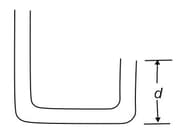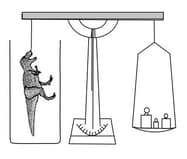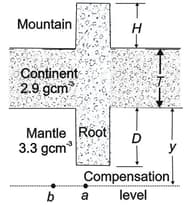In water flows steadily from the left pipe section (radius ), through the middle section (radius ), and into the right section (radius ). The speed of the water in the middle section is . What is the net work done on of the water it moves from the left section to the right section?



Important Questions on Fluids
The plastic tube in has a cross-sectional area of . The tube is filled with water until the short arm (of length ) is full. Then, the short arm is sealed and more water is gradually poured into the long arm. When the total height of water in the long arm reaches , the seal is on the verging of popping. What force is then, on the seal?

When researchers find a reasonably complete fossil of a dinosaur, they can determine the mass and weight of the living dinosaur with a scale model sculpted from plastic and based on the dimensions of the fossil bones. The scale of the model is ; that is, length are actual length, areas are actual areas, and volumes are actual volumes. First, the model is suspended from one arm of a balance and weights are added to the other arm until equilibrium is reached. Then the model is fully submerged in water and enough weights are removed from the second arm to re-establish equilibrium. For a model of a particular T. rex fossil, had to be removed to re-establish equilibrium. What was the volume of (a) the model and (b) the actual T. rex? (c) If the density of T. rex was approximately the density of water, what was its mass?

In analysing certain geological features, it is often appropriate to assume that the pressure at some horizontal level of compensation deep inside Earth is the same over a large region and is equal to the pressure due to the gravitational force on the overlying material. Thus, the pressure on the level of compensation is given by the fluid pressure formula. This model requires, for one thing, that mountains have roots of continental rock extending into the denser mantle. Consider a mountain of height, on a continent of thickness, . The continental rock has a density of and beneath this rock, the mantle has a density of . Calculate the depth of the root.

